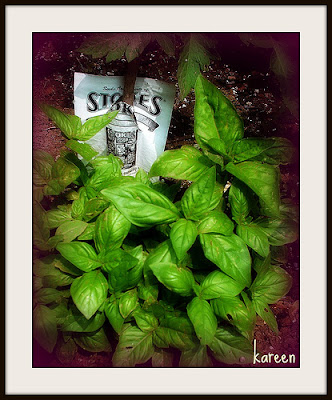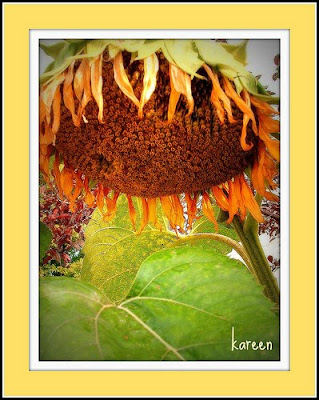One activity enriches the other.
In my gardens, I grow flowers and vegetables, deciduous trees, evergreens and fruit-bearing bushes like service berry, blackberry and bittersweet to attracts birds. The perennials produce nesting material and seeds. The blue spruce and maple trees are poplar roosting spots. Catnip seeds are a favorite of the goldfinch and the purple thistle's down is used to line their nests. After the vegetable garden is put to bed, the resulting compost becomes a favorite spot for birds. Spent perennial beds become niches to explore for seeds and dirt for dry bathing.
Visiting birds, in turn eat harmful insects like cabbage worms, larvae and moths. They assist in pollination. Birds bring beauty and inspiration as they travel between cone flower, cosmos and bee balm, or perch in the trees singing their songs. Through the years, birds have also brought "volunteers" to my garden. An oak tree and a swamp willow are two of the trees they have planted. It's as if they too want a say in what should grow in their backyard!
This summer, a squash plant of unknown origin (possibly from a cross-pollinated seed), flourished in the spot chosen by some enterprising bird. Dropped adjacent to a graveled spot under the bay window, in a year when growing pumpkins was difficult (a wet spring, followed by a long, hot and dry summer) this one plant produced close to a dozen fruit. Shaped like spaghetti squash and bright orange like a pumpkin, I decorated for fall with these complimentary "Jack-o-lanterns."
In my gardening journal, I note the migration of birds, and birds that stay near us year-round. On a cold winter day like today, I like to read my entries:
March 19, 2005: Outside the kitchen window, I saw the first red-winged blackbird of the season, feeding alongside some grackles.
March 4, 2000: Sighted male and female bluebirds at end of property, near the bluebird house.
March 8, 2011: Spotted two buzzards (turkey vultures) overhead, near the Olentangy River.
February 28, 2010: A mockingbird is at the suet feeder. The snow is melting. Grass can be seen. Birds are bathing in the puddles that have formed.
January 29, 2000: One chickadee, several juncos and sparrows visited the feeders. Cold weather today. Snow expected tonight.
And sometimes, an unexpected bird, like a chukar or cock pheasant (escapees from a nearby hunting farm) makes it way into our backyard. For over a week now, a beautifully plumbed male pheasant has taken up residency near the purple plum and its many feeders. It finds refuge under the tall grasses along the fence and in the spent perennial beds, and low pine branches. This morning, as he ate the cracked corn I bought specially for him, I watched as he fed alongside the sparrows, finches and cardinals. The American crow, one of three that hangs around our property, flew in for his breakfast; then quickly flew out. He wasn't expecting a giant amongst the familiar flock of underlings:
I hope the pheasant decides to stay. And, if he decides to plant something, I promise I will tend to it :)























































